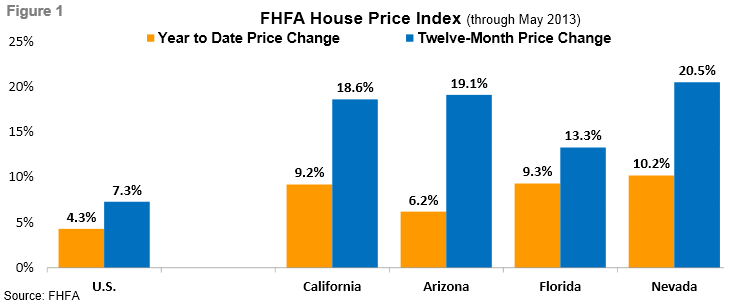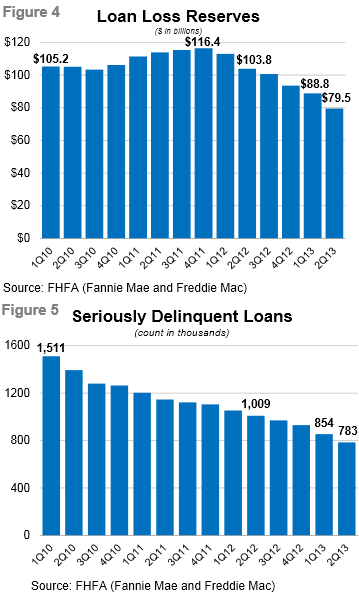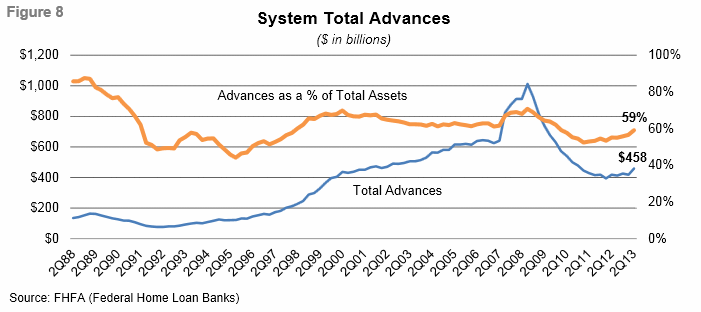Blog

FHFA Credits "Market Drivers" for GSE Earnings
On Thursday the Federal Housing FinancernAgency (FHFA) released the first QuarterlyrnPerformance Report of the Housing GSEs. Thernreport summarizes data on the two government sponsored enterprises (GSEs)rnFannie Mae and Freddie Mac which are in conservatorship under FHFA and thernFederal Home Loan Banks (FHLBanks) for which FHFA is the regulator.</p
Included in the report is information onrnthe three entities finances, activities over the previous quarter, as well asrndata on what FHFA calls the “market drivers,” home prices, mortgage interestrnrates, and swap rates. </p
FHFA says that both the GSEs and the FHLBanksrnreported positive earnings in the second quarter and this was significantly<binfluenced by house prices which rose 4 percent for the year-to-date that endedrnin May, the seventh consecutive quarterly price increase. Earnings also benefited from increasedrnhedging income driven by increases in interest rates in the secondrnquarter. </p
 </p
</p
The GSEs reported combined net income ofrn$15.1 billion in the quarter and $78.4 billion in the first half of 2013. The latter number was in large measure due tornFannie Mae’s release of a substantial portion of its valuation allowancernagainst deferred tax assets in Q1, resulting in the recognition of a $50.6rnbillion tax benefit. </p
The GSE’s portfolio quality continued tornimprove and the delinquencies of its legacy pre-2009 loans to decline. Rising prices lowered expected defaults onrnmortgages in most localities and reduced the severity of credit losses on salesrnof owned real estate (REO). Thesernfactors resulted in a $9.3 billion decrease in the GSEs combined loan lossrnreserves in the second quarter, resulting in a benefit of $6.0 billion; thernthird quarterly benefit in a row. Therernwas an aggregate gain of $2.6 billion in the second quarter and $3.5 billionrnfor the year-to-date accruing to the GSEs from fair value gains on derivativesrnused to hedge interest rate risk. </p
Seriously delinquent loans have also declinedrnby 8 percent to approximately 783,000. rnThis is down 22 percent from a year earlier.</p
 </p
</p
Refinancing continued to drive newrnbusiness volume, accounting for 79 percent of Fannie Mae’s business and 81rnpercent of Freddie Mac’s in the first half of the year. Refinancing through the Home AffordablernRefinance Program (HARP) remained high following enhancements made to thernprogram in late 2011. </p
The GSEs and Ginnie Mae continue tornaccount for essentially all issuances of mortgage-backed securities (MBS). In the first half of the year the GSEsrnaccounted for $728 billion or 77 percent of MBA issuances.</p
The FLHBank System generated $699rnmillion, an increase of 22 percent from the first quarter. Year-over-year the System earned $134 millionrnor 25 percent more than in the second quarter of 2012. “Focusingrnon the year-over-year figure, the higher net income was attributable to itemsrnin non-interest income – unrealized gains in derivatives and hedgingrnactivities, changes in fair value, and low credit impairment charges.”</p
Holdings of private-label MBS continuernto fall and are now 3 percent of assets. rnWhile the Banks have recorded cumulative credit impairment charges ofrn$4.0 billion on these MBS, charges in the second quarter were less than $1rnmillion.</p
Net interest income fell to 19 percent</byear-over-year because of reductions in yields on earning assets in thernprolonged low rate environment and declines in asset balances. Return on assets of 37 basis points was 6rnbasis points higher than in the first quarter and 7 higher than a yearrnearlier. </p
As of the end of the quarter the Banksrnhad combined assets of $775.2 billion, $36.3 billion more than the firstrnquarter and $15.5 billion above the assets in the second quarter of 2012. The quarterly increase was primarily causedrnby a $40.2 billion increase in advances which represented 59.1 percent ofrnassets at quarter-end compared to 56.6 percent on March 31, 2013. Investments decreased to 34.5 percent ofrnassets from 36.5 percent in the previous quarter and mortgages declined to 6.0rnpercent from 6.5 percent.</p
Advances plus acquired member assetsrn(AMA) average 65.4 percent of total assets across the system, ranging from 35.9rnpercent to 75.6 percent at each of the individual FHLBanks. These are two asset classes directly relatedrnto the mission of the System.</p
 </p
</p
At the end of the quarter the Systemrnheld $51.0 billion of regulatory capital and $43.1 billion of GAAP capital. The current System regulatory capital ratiornis 6.6 percent and the current GAAP capital ratio is 5.6 percent. Both ratiosrnmarginally decreased over the quarter. Retainedrnearnings now equal 1.5 percent of assets, the highest level in more than 20rnyears.
All Content Copyright © 2003 – 2009 Brown House Media, Inc. All Rights Reserved.nReproduction in any form without permission of MortgageNewsDaily.com is prohibited.
Latest Articles
By John Gittelsohn August 24, 2020, 4:00 AM PDT Some of the largest real estate investors are walking away from Read More...
Late-Stage Delinquencies are SurgingAug 21 2020, 11:59AM Like the report from Black Knight earlier today, the second quarter National Delinquency Survey from the Read More...
Published by the Federal Reserve Bank of San FranciscoIt was recently published by the Federal Reserve Bank of San Francisco, which is about as official as you can Read More...

Comments
Leave a Comment